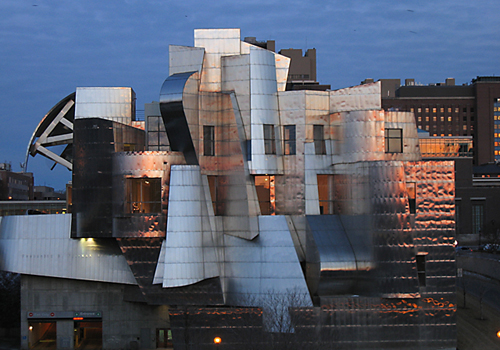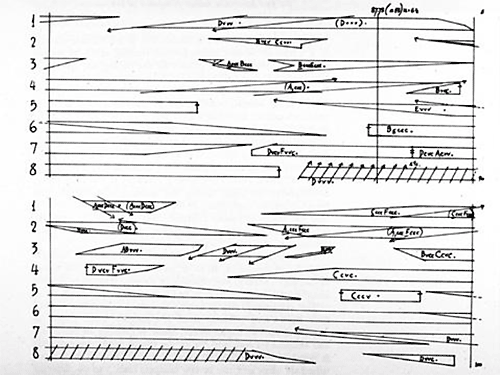

 subscribe
subscribeBefore boarding my flight to Minneapolis, my only association with this city, apart from the usual stereotypes one might have regarding the Midwest of the US, was the one of being the hometown of “the artist formerly known as Princeâ€. But my vague image of Minneapolis was to be replaced soon, as I was to attend the “Spark Festival of Electronic Music & Artâ€, hosted by the University of Minnesota.

The festival’s main focus was on electroacoustic composition and performance, although it also featured audiovisual works, installations showing resemblance to the works on display at London’s Cybersonica occasions, and gigs being held at a late evening venue.
It all started with a talk by Robin Rimbaud, the artist formerly known as Scanner. This talk coined Rimbaud as a shining ambassador of British humour and gave some nice insights into his work (more at www.scannerdot.com), and I wish I could write equally enthusiastic about his performance that followed this very evening.
Unfortunately his initial plan of jamming with a band located in New York via the internet failed due to technical difficulties. Again I had to ask myself the question what it actually is that makes jamming with remote participants so appealing, a process often being referred to with the hype-word “telejammingâ€, technically possible since the invention of the telephone. The most exciting moment of Rimbaud’s 45 minute long set was, quite predictably, a “scanned†telephone call, that actually was a pre-recorded one and undeniably had a “best of†feel to it.

The first day’s video program of the festival had been shown at the Weisman Art Museum, easily recognisable as a structure planned by Frank Gehry, an architect known for his Titanium covered curvaceous buildings. The program was dominated by humorous contributions, featuring animated desktop icons and a lot of Googled imagery combined with voiceovers, not far from video works by Doug Fishbone.
The morning talks on the second day gave some insights into the works of contemporary electroacoustic composers, working in the tradition of modern classical. Entirely new to me was the referral to Max/MSP patches as “interactive scoresâ€, articulated as a logical progression of scores in the tradition of John Cage.

John Cage, “Williams Mixâ€, 1952
Some projects presented focused on digitally re-modeling setups of classic electroacoustic compositions which - at the time - were involving specifically configured electronics, oscillators and tape machines. These setups now can be implemented more precisely and without any of the technical difficulties posed by ancient electronics using digital frameworks such as Max/MSP. One example of this culture that leaped out at me was David Wetzel’s work on re-implementing Jonathan Kramer’s Renascence, originally composed 1974 for clarinet, pre-recorded tape, and a tape delay system. In this piece the clarinet, later on also performed by Wetzel in a concert context, plays against itself in a recurring delay of 34 measures of music, with the aim to construct contrapuntal patterns. In pre-digital times it apparently took several hours to fine-tune the 34 measure tape delay system each time before performing the piece. God bless the digital revolution.
Later on the name Nathan Wolek caught my attention, well known for his work on granular synthesis abstractions for Max/MSP. In his performance, together with Matt Roberts, he quite predictably made usage of several granular synthesis approaches, articulated in a quite undifferentiated manor.
Very charming and enjoyable has been a talk by Alvin Lucier, telling many anecdotes about the likes of John Gage, David Tudor, Karl Heinz Stockhausen and Steve Reich. Lucier managed to paint a colourful picture of an era characterised by revolutionary changes in composition, and also talked about his electroacoustic classic “I am sitting in a room†(1969). For those unfamiliar with Lucier’s body of work, this piece starts with a recording of his own voice, narrating the text "I am sitting in a room, different from the one you are in now. I am recording the sound of my speaking voice. I regard this activity not so much as a demonstration of a physical fact, but more as a way to smooth out any irregularities my speech might have." Here he is referring to his stuttering. He then played this recording back into the room whilst re-recording it. The new recording is then played back again, and this process is repeated until eventually the resonant tones and harmonies of the room itself entirely replace the original recording.
A new piece using the same technique which Lucier presented afterwards - with classical music as a starting point instead of spoken text - was less convincing conceptually.
A few of Lucier’s compositions also have been featured in the electroacoustic concert series, and I have been especially glad to hear a performance of “Music for Accordion with Slow Sweep Pure Wave Oscillatorsâ€.
Electroacoustic concerts actually have been going on every day of the festival, ranging from performers folding papers in front of especially sensitive microphones to computer driven pieces such as controlling microphone feedback by the aid of custom designed software. One or the other piece presented has been composed by means that could be seen as an acoustic equivalent to William Latham’s method of working, breeding generations of compositions and then going through a selection process - generative eugenics, survival of the prettiest.
One of the pieces that especially grabbed my attention was a composition merely consisting of sound bites by Donald Rumsfeld, mainly statements about the Iraq war and weapons of mass destruction, cleverly focussing on all the “uuhs†and “aahs†inbetween words and hereby suggesting a sense of cluelessness.
Ben Nevile, a musician based in Vancouver and also a programmer working for Cycling74, gave a talk about Max/MSP/Jitter and his practice based PhD research at the University of Victoria, which includes building new electronic drum interfaces based on the detection of electromagnetic fields. Later on his sister in crime Randy Jones aka Caro played a humorous House set, also known for his jittering for Radiohead.
A paper that I particularly enjoyed was the one of Arun Saldanha with the topic “Music as Force: Sonic Interventions of Psy-Tranceâ€. Saldanha’s PhD focused on researching the cultural phenomenon of Trance parties in Goa, living “under cover†amongst the party community for more that 3 years as part of his research. Of Asian decent, Saldanha identifies fascist notions of the scene, describing mechanisms designed to ensure that Indian beggars would not interfere with the divine experience of sunrise on a Psy-Trance dancefloor.
The things described here are just a fraction of what was going on, meant to give an overall flavour of a 4 day festival with a tight schedule of events.
More than once I would run into communication difficulties, as my Austrian accent, slightly watered down during the last 10 years that I have lived in Britain, seemed to be particularly difficult for the local community to understand. On occasions being identified as Irish, it even became a struggle to order a “Hamburgerâ€, a word one would assume to be second nature to somebody working at an American style diner.
| Attachment | Size |
|---|---|
| Campus_500_350.jpg | 181.02 KB |
| Weisman_500_350.jpg | 182.57 KB |
| Cage_500_375.gif | 70.63 KB |